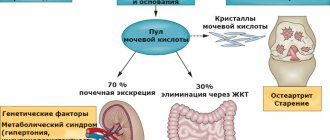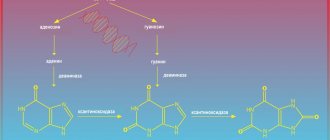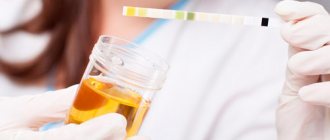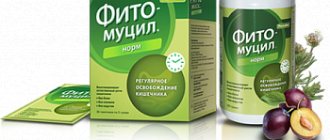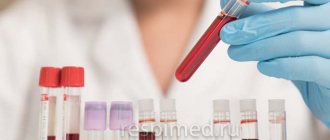In a healthy state, the body produces the substance during the processing of proteins and removes it through the gastrointestinal tract and kidneys. Uric acid can be elevated if there is a failure in its elimination or if it is over-produced by the liver.
An analysis for the determination of uric acid in the blood is important in the diagnosis of kidney diseases, gout, arthrosis and arthritis, since over time it transforms into crystals that accumulate in the joints, kidneys, gastrointestinal tract, heart and eye chambers.
Brief description of the disease
Gout is a well-known and well-studied disease associated with acute inflammation of the joints of the lower and upper extremities of a person, characterized by increased levels of uric acid, followed by crystallization and precipitation. Hyperuricemia is when the concentration of uric acid in serum or plasma exceeds 6.8 mg/dL (approximately 400 micromol/L). It should be noted that this level of uric acid is its approximate limit when it can crystallize.
Hyperuricemia (increased uric acid levels) is a necessary but not sufficient prerequisite for the development of gout (direct deposition of monosodium urate crystals). Doctors and patients should differentiate hyperuricemia from gout. Because most people with hyperuricemia never experience the clinical manifestations associated with urate crystal deposition, namely a gout attack.
The disease itself, with its clinical characteristics, has been described in the literature for more than two millennia, with its own interesting observations and studies. But it wasn't until the second half of the 20th century that evidence emerged that the cause of gout involved the deposition of uric acid (monosodium urate) crystals. The key point is the introduction into clinical practice of microscopes using polarized light, which ensured the identification of urate crystals in the synovial fluid of the joints (intra-articular fluid).
Thus, an end was put to the mechanism of this disease and the ambiguous connection between hyperuricemia and gout was resolved. Further study of this disease has expanded the understanding of the molecular pathophysiology of inflammation in gout, thereby helping to create effective drugs for the treatment of such a common and well-known disease.
The further development of drugs that can suppress acute inflammation and eliminate elevated levels of uric acid in the body has provided the opportunity to completely eliminate the previously destructive effects of chronic and acute inflammatory processes.
Although modern drugs have had a beneficial effect on the course of gout in most people, this disease remains a pressing problem today, often with unsatisfactory clinical outcomes, despite successful treatment attempts. This is very common for poorly trained patients, or for patients who do not strictly follow our recommendations.
NETWORK OF BIOMEDICAL CENTERS IN COMUNIDAD VALENCIANA, ESPAÑA-ASCIRES
Sample menu for the week
The diet should be compiled by a nutritionist, taking into account the weight and other physiological parameters of the patient. But a sample menu for the week looks like this:
- Monday. Breakfast – milk and toast with jam or honey. Lunch – fried potatoes in olive or flaxseed oil, vegetable cabbage soup, preferably with fresh cabbage. Dinner – vegetable stew, maybe with fish.
- Tuesday. Breakfast – cheesecakes with cottage cheese, tea with lemon or orange. Lunch – vegetable soup and cabbage rolls, but without meat (so-called “vegetarian” cabbage rolls with zucchini). Dinner – vinaigrette, sandwich with cheese (use flatbread, not bread).
- Wednesday. Breakfast - cottage cheese with sour cream, fruit or dried fruit. Lunch – cheese soup with chicken. Dinner – vegetable stew, fruit salad and compote.
- Thursday. Breakfast - omelet with herbs, onions and garlic, maybe with tomatoes. Lunch – vegetable okroshka, maybe with chicken breast. Dinner – potatoes with vegetables, tea with lemon.
- Friday. Breakfast – soft-boiled egg, cottage cheese with fruit. Lunch – buckwheat soup and boiled fish fillet (can be baked, with vegetable oil). Dinner – vegetable salad and cheese slices (without smoked or rennet cheese).
- Saturday. Breakfast – pancakes with jam. Lunch – noodles and potato casserole, or maybe stewed potatoes, but without meat. Dinner – vegetable salad with sour cream, cheese and olives.
- Sunday. Breakfast - oatmeal with milk, as well as freshly squeezed carrot juice. Lunch – fried potatoes with sour cream. Dinner – dumplings with cottage cheese or cabbage (at your discretion).
You can add afternoon snacks to the menu; they should mainly consist of fermented milk products, fresh fruits, vegetables, and dried fruits.
What to take during an acute attack of Gout?
NSAIDs. Non-steroidal anti-inflammatory drugs.
First aid for an acute gout attack is to prescribe a strong oral NSAID such as naproxen (500 mg twice daily) or indomethacin (50 mg three times daily) as a good alternative to glucocorticoids to treat a gout flare. Particularly effective for young patients who are under 60 years of age, without renal or cardiovascular comorbidities or active gastrointestinal diseases.
Non-selective NSAIDs of all types are inexpensive, easy to buy over the counter (some without a prescription), and, in our experience, are as effective and safe as other drugs in treating a gout attack. Other drugs in this class that may be used include ibuprofen (800 mg three times daily), diclofenac (50 mg twice daily), meloxicam (15 mg daily), and celecoxib (200 mg twice daily).
-Remember! Do not take more than one NSAID at a time! Those. You cannot take Ibuprofen and Diclofenac at the same time, simply because it helps you.
Anti-inflammatory drugs are most effective when treatment is started within the first 48 hours after symptoms appear. The dose may be reduced once symptoms have significantly improved, but dosing frequency should be maintained for several more days to achieve optimal anti-inflammatory effect.
Celecoxib , a selective cyclooxygenase (COX)-2 inhibitor, is a very good alternative to ibuprofen, meloxicam, diclofenac (non-selective NSAIDs) for gout flares, one dose of celecoxib at a dose of 200 mg, for no more than two weeks. In practice, we often use 200 mg twice daily, which is the maximum dose recommended for rheumatoid arthritis.
Any NSAID (ibuprofen) can be discontinued two to three days after the complete disappearance of clinical signs. Typically, the total duration of naproxen therapy for a gout flare is five to seven days. The clinical picture is likely to be shorter in patients treated within the first 24 hours of symptom onset.
Colchicine / Colchicina / Colchimax / Colchicine
For me, an ideal alternative to glucocorticoids (pridnisone) or NSAIDs (ibuprofen) is colchicine , which has actually been shown to be more effective than other drugs if taken within 24 hours of the onset of a gout flare. Colchicine should be taken 1 mg once daily until the outbreak resolves. In some countries, colchicine is available as a 0.5 mg tablet rather than a 0.6 mg tablet. The maximum dose is 2 mg per day according to new treatment protocols. Previously, up to 6 mg per day was used, but this is an old regimen and is no longer used due to the likelihood of side effects.
It is worth noting the toxicity of the drug if used incorrectly. Therefore, we recommend that you consult your doctor before taking it. The main side effect of colchicine is diarrhea and vomiting. Patients and professionals should be very alert to the interactions of colchicine with the following drugs: macrolide antibiotics (azithromycin, clarithromycin, erythromycin), cyclosporine, tacrolimus, amiodarone, quinidine, azole antifungals (ketoconazole), verapamil, CYP3A4 inhibitors (HIV therapy, ritonavir , cobicistat).
Colchicine is a particularly useful option for patients already taking allopurinol and whose gout flare phase is in the early stages. We often meet patients who are familiar with their disease, but have not heard anything about colchicine.
If you have any questions, sign up for a consultation
Does your lifestyle affect your uric acid levels? Eliminate the following foods from your diet... Find out in this article.

There used to be a so-called gout demographic profile that followed the "classic" example: a man between 30 and 60 years old suffering from gout attacks, who was also likely to be obese, have hypertension (high blood pressure) and drink alcohol frequently.
But “non-classical” risk groups have emerged that are becoming increasingly common, and these patient groups are very different from the “classic profile.” This includes older patients, organ recipients, people taking diuretics, cancer patients, the use of drugs such as cyclosporine or tacrolimus (calcineurin inhibitor), and, unfortunately, the proportion of women with symptoms of gout has also increased.
Fully or partially limited products
To reduce uric acid levels, sharply limit:
- Offal (lungs, liver, tongue, kidneys, brains).
- Meat, meat products and any types of canned meat. Animal protein is limited to 1 g per 1 kg of weight. The red meat of young animals contains the highest amount of purines.
- Fish dishes (especially carp, halibut, anchovies, sea bass, sardines, tuna, mussels and herring) and canned food.
- Fish/meat/mushroom broths. In rare cases, you can use secondary broth (the first one is drained after boiling for 10 minutes).
- Sorrel and legume soups.
- Vegetables rich in oxalic acid (sorrel, radishes, cauliflower, asparagus, spinach, raspberries, cranberries), pickled vegetables.
- Cheeses, broth-based sauces (you can make them using vegetable broth).
- Legumes and mushrooms (porcini and champignons).
- Oatmeal and white rice.
- Chocolate, cocoa, red wine, tea and coffee, which contain purines.
- Confectionery products, brewer's yeast.
- Dried fruits (prunes are possible).
- Foods that stimulate the nervous system (spicy snacks and spices).
- Alcohol, the consumption of which can provoke gout attacks.
Table of prohibited products
| Proteins, g | Fats, g | Carbohydrates, g | Calories, kcal | |
Vegetables and greens | ||||
| spicy vegetables | 2,8 | 0,5 | 5,3 | 36 |
| vegetables legumes | 9,1 | 1,6 | 27,0 | 168 |
| cauliflower | 2,5 | 0,3 | 5,4 | 30 |
| green onion | 1,3 | 0,0 | 4,6 | 19 |
| bulb onions | 1,4 | 0,0 | 10,4 | 41 |
| canned cucumbers | 2,8 | 0,0 | 1,3 | 16 |
| pickles | 0,8 | 0,1 | 1,7 | 11 |
| radish | 1,2 | 0,1 | 3,4 | 19 |
| white radish | 1,4 | 0,0 | 4,1 | 21 |
| turnip | 1,5 | 0,1 | 6,2 | 30 |
| celery | 0,9 | 0,1 | 2,1 | 12 |
| tomatoes | 0,6 | 0,2 | 4,2 | 20 |
| canned tomatoes | 1,1 | 0,1 | 3,5 | 20 |
| horseradish | 3,2 | 0,4 | 10,5 | 56 |
| garlic | 6,5 | 0,5 | 29,9 | 143 |
| spinach | 2,9 | 0,3 | 2,0 | 22 |
| sorrel | 1,5 | 0,3 | 2,9 | 19 |
Fruits | ||||
| avocado | 2,0 | 20,0 | 7,4 | 208 |
| pineapples | 0,4 | 0,2 | 10,6 | 49 |
| kiwi | 1,0 | 0,6 | 10,3 | 48 |
Berries | ||||
| cranberry | 0,5 | 0,0 | 6,8 | 26 |
| raspberries | 0,8 | 0,5 | 8,3 | 46 |
Mushrooms | ||||
| mushrooms | 3,5 | 2,0 | 2,5 | 30 |
| marinated mushrooms | 2,2 | 0,4 | 0,0 | 20 |
Cereals and porridges | ||||
| white rice | 6,7 | 0,7 | 78,9 | 344 |
Confectionery | ||||
| pastry cream | 0,2 | 26,0 | 16,5 | 300 |
| cake | 3,8 | 22,6 | 47,0 | 397 |
Cakes | ||||
| cake | 4,4 | 23,4 | 45,2 | 407 |
Chocolate | ||||
| chocolate | 5,4 | 35,3 | 56,5 | 544 |
Raw materials and seasonings | ||||
| mustard | 5,7 | 6,4 | 22,0 | 162 |
| yeast | 12,7 | 2,7 | 0,0 | 75 |
| brewer's yeast | 12,7 | 2,7 | 0,0 | 75 |
| ginger | 1,8 | 0,8 | 15,8 | 80 |
| ketchup | 1,8 | 1,0 | 22,2 | 93 |
| cinnamon | 3,9 | 3,2 | 79,8 | 261 |
| mayonnaise | 2,4 | 67,0 | 3,9 | 627 |
| ground black pepper | 10,4 | 3,3 | 38,7 | 251 |
| dried parsley | 22,4 | 4,4 | 21,2 | 276 |
| caraway | 19,8 | 14,6 | 11,9 | 333 |
| dried dill | 2,5 | 0,5 | 6,3 | 40 |
Meat products | ||||
| salo | 2,4 | 89,0 | 0,0 | 797 |
| beef | 18,9 | 19,4 | 0,0 | 187 |
| beef liver | 17,4 | 3,1 | 0,0 | 98 |
| beef kidneys | 12,5 | 1,8 | 0,0 | 66 |
| boiled beef tongue | 23,9 | 15,0 | 0,0 | 231 |
| beef brains | 9,5 | 9,5 | 0,0 | 124 |
| veal | 19,7 | 1,2 | 0,0 | 90 |
| calf liver | 19,2 | 3,3 | 4,1 | 124 |
| lamb | 16,2 | 14,1 | 0,0 | 192 |
Bird | ||||
| smoked chicken | 27,5 | 8,2 | 0,0 | 184 |
| duck | 16,5 | 61,2 | 0,0 | 346 |
| smoked duck | 19,0 | 28,4 | 0,0 | 337 |
| goose | 16,1 | 33,3 | 0,0 | 364 |
Fish and seafood | ||||
| dried fish | 17,5 | 4,6 | 0,0 | 139 |
| smoked fish | 26,8 | 9,9 | 0,0 | 196 |
| canned anchovies | 20,1 | 6,1 | 0,0 | 135 |
| black caviar | 28,0 | 9,7 | 0,0 | 203 |
| salmon caviar granular | 32,0 | 15,0 | 0,0 | 263 |
| carp | 16,0 | 5,3 | 0,0 | 112 |
| boiled crabs | 16,0 | 3,6 | 0,0 | 96 |
| mussels | 9,1 | 1,5 | 0,0 | 50 |
| sea bass | 15,3 | 1,5 | 0,0 | 79 |
| boiled halibut | 14,0 | 17,8 | 0,0 | 216 |
| canned fish | 17,5 | 2,0 | 0,0 | 88 |
| sardine | 20,6 | 9,6 | — | 169 |
| herring | 16,3 | 10,7 | — | 161 |
| cod | 17,7 | 0,7 | — | 78 |
| cod (liver in oil) | 4,2 | 65,7 | 1,2 | 613 |
| boiled oysters | 14,0 | 3,0 | — | 95 |
| fresh oysters | 14,0 | 6,0 | 0,3 | 95 |
| pike | 18,4 | 0,8 | — | 82 |
Oils and fats | ||||
| animal fat | 0,0 | 99,7 | 0,0 | 897 |
| cooking fat | 0,0 | 99,7 | 0,0 | 897 |
Non-alcoholic drinks | ||||
| cocoa powder | 24,2 | 17,5 | 31,9 | 374 |
| * data is per 100 g of product | ||||
What are the clinical manifestations of gout flares?
Persistent and elevated levels of uric acid in the body (hyperuricemia) is a common biochemical abnormality that results from excessive production of uric acid (urate) or when the kidneys do not eliminate uric acid .
Therefore, in all patients with gout during their illness, hyperuricemia (saturation of blood serum with urate) is always observed. However, most people with hyperuricemia never experience the clinical manifestations of gout associated with urate crystal deposition.
Clinical manifestations of gout include:
- Recurrent outbreaks of inflammatory arthritis (gout flare). Most often in autumn and spring.
- Do you have a sharply inflamed toe joint on your right foot? Read below what this is connected with.
- This is severe and acute pain in the joint, redness, the joint “burns,” swelling, and inability to walk. And usually the patient says that there was no injury! The picture itself usually appears within 12-24 hours, which is quite fast in itself and is typical for this attack. Complete resolution of the earliest outbreaks almost always occurs within a few days to a few weeks, even in untreated people.
- Gout flares are twice as likely to occur during the night and early morning than during the day. Patients often say that they cannot stand on their leg in the morning because, in their words, “the knee suddenly became inflamed overnight, but yesterday everything was fine, and I didn’t hit my leg anywhere.”
- Damage to the lower extremities. Most initial outbreaks affect at least one joint, most often at the base of the big toe (the first metatarsophalangeal joint, known as gout) or the knee.
- Recurrent joint problem, chronic arthropathy.
Can gout affect the joints of the fingers and elbows?
Yes maybe! Multi-joint gout flares – The multi-joint pattern is the initial presentation in a small number of patients with gout, but with increasing frequency in subsequent flares. Multi-joint symptoms are especially common in the later stages of untreated gout, when multiple relapses are common. Fingers, elbows, upper jaw.
Signs of inflammation that extend beyond the joint are caused by arthritis in several adjacent joints or tenosynovitis. Unusual involvement of the vertebral joints and sacroiliac joints, where gout may be much less common, which can cause diagnostic confusion. The area most often affected is the lumbar spine. However, most proven cases of gout, which manifests itself as acute or chronic back pain, have been associated with damage to the stomach. There may also be neurological signs and symptoms.
Accumulation of uric acid crystals in the form of external deposits.
Tophi are characteristic accumulations of solid urate, accompanied by chronic inflammatory and often destructive changes in the connective tissue. Tophi are often visible, can be touched and felt (palpated), and may be present on the ears or in soft tissues including joint structures, tendons, or periarticular bursae. Tophi (tophi) usually do not hurt and are hard in structure. They are visible on the skin and have a slightly yellow or white color. On the ear they appear in the form of balls and do not allow light to pass through.
Note for medical students and doctors
-Chronic inflammatory process extending beyond one joint due to uric acid deposition is reminiscent and similar to dactylitis seen in other diseases such as psoriatic arthritis, other spondyloarthritis and sarcoidosis. The expansive and destructive changes associated with gouty gout may be mistaken for osteomyelitis and sometimes lead to erroneous amputation of the involved digits.
Deposition of uric acid crystals in the kidneys. Nephrolithiasis.
Uric acid stones account for 5 to 10 percent of all kidney stones worldwide; however, they make up 40 percent or more of the stones in hot, dry climates. The most important biochemical risk factor for the development of urolithiasis is a persistently low urine pH. And low urine volume (with a high concentration of uric acid in the urine) and acidic urine pH promote the conversion of the relatively soluble urate salt to insoluble uric acid.
Patients usually have an attack of renal colic and complain of acute pain in the right or left side. Computed tomography (CT) without contrast/dye usually reveals the presence of a stone. For many patients, we recommend that the diagnosis be confirmed by chemical analysis of the stone. It is worth noting that on ordinary radio photographs, stones consisting of uric acid are transparent and almost impossible to notice.
Chronic nephropathy, which in gouty patients most often occurs due to concomitant conditions.
Chronic urate nephropathy is the last stage of chronic kidney disease in chronic gout, caused by the deposition of uric acid crystals in the kidneys (medullary interstitium). The crystals cause a chronic inflammatory response similar to that seen when tophi form in other parts of the body, ultimately leading to interstitial fibrosis and chronic kidney disease.
Clinical stages of the disease (“Gout flares,” “Recurrent gout flares,” “Chronic gout”) occur sequentially, with corresponding clinical severity that often coincides with the frequency of gout flares. Therefore, treatment with uric acid-lowering drugs (antihyperuricemics) is restraining and ensures effective recovery of the patient if the urate saturation level does not increase above <6 mg/dL or 357 micromol/L.
Go to top
